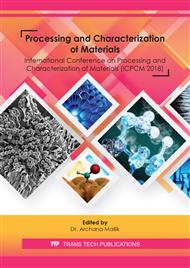[1]
J.C. Knight, T.A. Birks, P.St. J. Russell, D.M. Atkin, All-silica single-mode optical fibre with photonic crystal cladding, Opt. Lett. 21 (1996) 1547–1549.
DOI: 10.1364/ol.21.001547
Google Scholar
[2]
T.A. Birks, J.C. Knight, P.S. Russell, Endlessly single-mode photonic crystal fibre, Opt. Lett. 22 (1996) 961–963.
DOI: 10.1364/ol.22.000961
Google Scholar
[3]
P.St. J. Russell, Photonic crystal fibres, Science 299 (2003) 358–362.
Google Scholar
[4]
J.C. Knight, Photonic crystal fibres, Nature 424 (2003) 847–851.
Google Scholar
[5]
P.N. Prasad, Introduction to Biophotonics, John Wiley & Sons, (2004).
Google Scholar
[6]
M.A. Islam, R. Ahmad, M.S. Ali, K.M. Nasim, Proposal for highly residual dispersion compensating defected core decagonal photonic crystal fibre over S+ C+ L+ U wavelength bands, Opt. Eng. 53 (2014).
DOI: 10.1117/1.oe.53.7.076106
Google Scholar
[7]
H. Ademgil, S. Haxha, PCF based sensor with high sensitivity, high birefringence and low confinement losses for liquid analyte sensing applications, Sensors 15 (2015) 31833–31842.
DOI: 10.3390/s151229891
Google Scholar
[8]
S.S. Lin, S.K. Hwang, J.M. Liu, Supercontinuum generation in highly nonlinear fibres using amplified noise-like optical pulses, Opt. Express 22 (2014) 4152–4160.
DOI: 10.1364/oe.22.004152
Google Scholar
[9]
H. Ademgil, S. Haxha, Highly birefringent nonlinear PCF for optical sensing of analytes in aqueous solutions, Optik 127 (2016) 6653–6660.
DOI: 10.1016/j.ijleo.2016.04.137
Google Scholar
[10]
M.A. Islam, R. Ahmad, M.S. Ali, K.M. Nasim, Proposal for highly residual dispersion compensating defected core decagonal photonic crystal fibre over S+ C+ L+ U wavelength bands, Opt. Eng. 53 (2014).
DOI: 10.1117/1.oe.53.7.076106
Google Scholar
[11]
Dingying Shan, Ethan Gerhard, Chenji Zhang, John William Tierney, Daniel Xie, Zhiwen Liu, Jian Yang, Ploymeric biomaterials for biophotonic applications, Bioactive Materials 3 (2018) 434-445.
DOI: 10.1016/j.bioactmat.2018.07.001
Google Scholar
[12]
T.J. Yang, L.F. Shen, Y.F. Chau, M.J. Sung, D. Chen, D.P. Tsai, High birefringence and low loss circular air-holes photonic crystal fibre using complex unit cells in cladding, Opt. Commun. 281 (2008) 4334–4338.
DOI: 10.1016/j.optcom.2008.05.008
Google Scholar
[13]
K. Naeem, B.H. Kim, Y. Chung, High-sensitivity temperature sensor based on a selectively-polymer-filled two-core photonic crystal fibre in-line interterometer, IEEE Sens.J.15 (2015) 3998-4003.
DOI: 10.1109/jsen.2015.2405911
Google Scholar
[14]
Y. Yu, X. Li, X. Hong, Y. Derrg, K. Song, Y. Geng, H. Wei, W. Tong, Some features of photonic crystal fibre temperature sensor with liquid ethanol filling, Opt. Exp, 18 (2010) 15383-15388.
DOI: 10.1364/oe.18.015383
Google Scholar
[15]
T.T. Larsen, A. Bjarklev, Optical devices based on liquid crystal based on photonic bandgap fibres, Opt. Exp.11 (2003) 2589-2596.
DOI: 10.1364/oe.11.002589
Google Scholar
[16]
Weicheng Cai, Exian Liu, Bo Feng, Hongfei Liu, Ziming Wang, Wei Xiao, Taiyuan Liang, Shuo Wang, Jianqiang Liu, Jianjun Liu, Dispersion properties of a photonic quasi-crystal fibre with double cladding air holes, Optik – Int. J. Light Electron Opt. 127 (2016) 4438–4442.
DOI: 10.1016/j.ijleo.2016.01.134
Google Scholar


